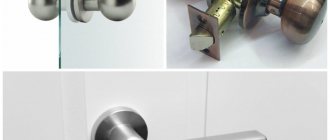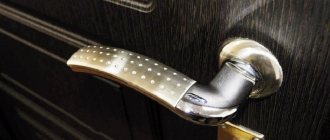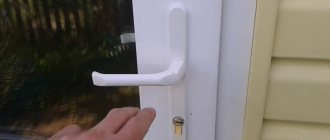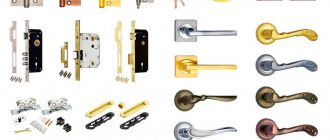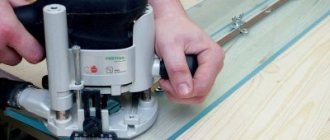In order for a plastic door to work properly, it is necessary to ensure trouble-free operation and regularly monitor the technical condition of all parts, including the handle. With constant use, the mechanism can wear out, causing it to start to wobble, turn poorly, or break off. And then the question arises, how to repair the handle on a plastic door?
How to tighten a loose handle, or remove and replace it with a new one
on a PVC balcony
If you are not planning a replacement, but just want to secure a loose connection, all you need to do is tighten the fastening screws with a screwdriver. Sequencing.
- We turn the handle so that it is in a strictly horizontal position, as if you were going to open a window or door.
- There is a rectangular shaped plug above the surface of the door. You need to push it towards yourself a little and turn it 90 degrees.
- Now the heads of the screws have become visible, which just need to be tightened with a Phillips or regular screwdriver.
- Now we test the mechanism several times and return the plug to its place if everything is in order.
Sealing small cracks
To repair cracks and scratches you will need a cleaner, filler and liquid plastic.
Instructions:
- Defects, cracks and the area around should be washed with soapy water and wiped dry.
- Next, the defect is treated with a cleaner. You don't need much of it since it acts as soil.
- We fill the defect with liquid plastic and level the surface with a rubber spatula if the crack is large or polish it with a paper napkin if it is small.
Do not use colored fabric or synthetic napkins with Cosmofen liquid! Only paper ones, since Cosmofen dissolves paint and synthetic fabric.
Problems with the door structure
The need to repair a PVC balcony door may be caused by a malfunction of the door structure, in which the leaf stops closing or opening normally. In such situations, you should never apply excessive force, as you can damage the fittings, which will lead to higher repair costs.
The shutter opened in two positions and does not close
Opening in two positions at once - rotary and inclined - is a common problem with plastic structures. Occurs when, with the door open, the door handle is moved to a vertical position, as a result of which the upper opposite corner falls out of engagement and sags. In this case, the handle is blocked, so it is impossible to close the balcony.
To prevent such a situation, special locks are used that prevent the handle from rotating when the sash is open.
You can repair a plastic balcony door if it does not close in the following way:
- Press the top corner, located near the hinge, onto the door frame.
- Move the handle to a horizontal position.
Repairing a sagging balcony door is easy
The door is blocked and will not open
If the balcony door does not open, to gain access to the balcony you need to:
- Grab the door handle with one hand and the opposite upper corner of the door with the other.
- Pull the angle towards you and move the handle to a horizontal position.
- Open the balcony. In this case, the door will be in tilt and turn mode.
- Press the upper corner against the frame and move the handle to a vertical position, then return it to the horizontal position.
This will return the door to normal operation.
When jammed, the handle rotates a maximum of 45°
The door creaks and jams
If the balcony door does not close well and also creaks, it is most likely time to lubricate the fittings. First of all, the moving elements of the locking mechanism installed around the perimeter of the blade must be lubricated.
It is not recommended to use oils and fats containing acids or resins for lubrication.
Lubrication diagram for locking mechanism and hinges
The door may close poorly not only with an increase in the friction force of the mechanisms due to a lack of lubricant. Over time, the canvas sags under its weight, causing it to touch the frame. Repair in this case consists of adjusting the door leaf relative to the horizontal and vertical axes. To do this, special adjustment bolts are located on the upper and lower hinges, the rotation of which leads to the tilting or lifting of the blade.
Sash adjustment diagram horizontally and vertically
Useful video on the topic
Detailed video guide for troubleshooting balcony doors:
- Adjusting the tilt and turn sash “up and down” will help if the scissors rub against the frame when opening or closing the door.
- Wedging the sash - will help if the sash is sagging and adjusting with screws does not give the desired result;
- What to do if the balcony latch does not hold;
- How to remove scratches on white or laminated PVC profile;
- What to do if the sash does not fit the frame.
How to independently adjust the door to the balcony:
Most problems with a balcony block can be fixed with your own hands, saving on calling a technician. If it was not possible to repair a plastic or other door on the balcony using the methods described, contact a professional. Otherwise, you can only aggravate the breakdown, which will lead to higher repair costs.
YOU MAY ALSO BE INTERESTED
Modifications of balcony locking devices
All devices for balcony doors that are available on the Russian market today can be divided into the following categories:
- one-sided type;
- double-sided sample with asymmetry;
- with anti-burglary function;
- with a lock;
- shell;
- petal.
The single-sided handle is simple and easy to use. It does not have any special functionality and is optimal if there is no need to unlock the balcony from the opposite side.
The double-sided asymmetrical model looks the same on both sides of the balcony. It is similar to one-sided, but much more convenient, and has a mechanism made of durable metal.
The device is equipped with a special anti-burglary function. Ideal for owners of balconies on lower floors. Having a specialized mechanism, it makes it possible to protect yourself from intruders. The device is equipped with a special anti-burglary function. Ideal for owners of balconies on lower floors. Having a specialized mechanism, it makes it possible to protect yourself from intruders.
The petal design is not equipped with a standard mechanism with a locking option. As a rule, it is created from fairly durable plastic. The petal handle is fixed from the outside using self-tapping screws. A special decorated cover hides all holes intended for fastening
This type of locking device helps reduce heat loss, which is extremely important in cold weather
The shell-type locking device is produced in two versions - aluminum and plastic. As a rule, they tend to fix such a model from the side of the balcony. Its purpose is to close the balcony from the inside. This type of fittings is convenient for those who like to smoke a cigarette on the balcony or for people who often go out onto it. If there are small children in the family, a locking device coupled with a latch on the door will be extremely useful. The shell is mainly included in the standard configuration of the balcony structure. It is fixed without problems and does not create any special problems during operation.
Selection principles
A handle that meets certain characteristics is mounted on the balcony door. You need to know them.
- Resistance to temperature fluctuations. This is extremely important. For example, a locking device made of metal can burn your hand due to the influence of temperature in the summer, and freeze it in the winter. Handles made of wood and plastic (PVC) do not have this drawback. Aluminum products are expensive, but their service life is longer.
- Resistant to moisture. When the temperature changes, condensation forms on the shut-off device. A high-quality product does not corrode and remains operational for a long time.
- Safety. Unglazed (open) balconies on the lower floors require protection from unauthorized entry into the home. The double-sided locking device poses a threat. For security, the external part must be equipped with a lock.
- Thermal protection. The handle and its location must guarantee good impermeability, which means complete protection against the penetration of cold air. There are locking devices with protection devices.
- Easy to use. There is no one willing to fiddle with the locking mechanism for a long time to get onto the balcony. There are simple shell-shaped devices that can be opened by hand without any problems.
- Features of the door. It’s better to make sure at the time of purchase that the model will fit your door sample. Be sure to check the performance and functionality of the product directly in the store, with the seller. It should have a smooth and free move.
How to adjust a plastic balcony door in different situations
When independently adjusting plastic balcony doors, you should take into account the specific situation. The sash may not press well, sag or have other defects. After troubleshooting, you need to prepare a set of tools consisting of hexagons, flat or shaped screwdrivers.
General diagram for making adjustments
Actions to take if the handle becomes loose
One of the easiest tasks is to adjust the handle. They very often become loose, especially if used under extreme conditions. When carrying out work, turn the plastic cap located at the base 90 degrees.
Usually a double-sided handle is used
Underneath there are screws that need to be tightened with a screwdriver. During such activities, careless movements must be avoided so as not to damage the handle body. If tightening does not give a positive effect, then you should check the base for cracks. If any are found, the handle should be replaced.
Setting the clamping density
Most often, it is the pressure adjustment of the balcony plastic door that is adjusted, since this event is seasonal. In the summer, the clamps are loosened, and in the winter, they are tightened. This is primarily due to the expansion and contraction of plastic due to temperature fluctuations.
Layout of closing eccentrics
To check the tightness of the clamp, you need to take a regular sheet of paper and clamp it between the door leaf and the frame. If after closing there are no difficulties when pulling out, then adjustment is simply necessary. If the sheet is clearly fixed, the work can be skipped.
So, if the plastic balcony door does not close tightly, then special measures are taken to adjust the eccentrics. Adjustment is made using suitable hexagons. In some cases, pliers may be required.
The door ledge must be tight
From the rear side, the sash is adjusted using screws located on the lower and upper hinges. Usually, instructions are supplied with the fittings, which indicate the adjustment diagram. However, even in its absence, problems usually do not arise during setup.
It is necessary to rotate the eccentrics in one direction to adjust the plastic balcony door for the winter. Just when moving, an important landmark will be a special notch. Modern designs in most cases are equipped with such an indicator.
To configure, you will need a set of hexagons
In summer, the parts must be rotated in the opposite direction, taking into account the indications of the notch.
Carrying out measures when touching edges
If problems arise with the movement of the sash relative to the frame, it is necessary to adjust the bolts located directly in the hinges. A standard door has three fixation points. Having opened the sash completely, you should unscrew the fastening element holding the decorative strip.
The top hinge of the sash is adjustable
After this, the door closes, and the lining itself is carefully removed from the hinges. As a result, access must be provided to a long bolt, through which the position of the sash in a horizontal position is adjusted. If you need to move the door slightly to the right or left, you will have to make adjustments in three places at once. If there is sagging, you only need to tighten the screws in two hinges.
If necessary, the door can be completely removed from its hinges
If the lower part is shifted to one side or the other, you will have to rotate the lower hinge bolt and move it horizontally.
Eliminating blowing
Let's look at how to repair a plastic door if it starts to blow in or doesn't close tightly. In this case, you will need to adjust the fittings. To see how to do this, watch the video below:
Troubleshooting steps:
- Remove the decorative trims from the hinges.
- We determine the vertical level of the sash relative to the frame using a plumb line.
- We mark the places where the sash engages the frame with a water-soluble marker.
- We make adjustments with a hexagon, adjusting the sash pressure.
To lift the sash up, insert the hexagon into the upper hole of the lower hinge, located in its outer part. On this trunnion, as if you can adjust the hinges of a plastic door with a handle. Turn the hex wrench clockwise. To lower the sash, turn it counterclockwise.
To move the door to the left or right, insert the hexagon into the hole on the inside of the bottom hinge and turn it in the desired direction.
When adjusting the fittings, we take into account that the degree of connection of the sash to the frame varies by twisting the top hinge.
Main stages
Balcony cladding and insulation
In order for the loggia to become a truly warm room, insulation is necessary both outside and inside. Siding is perfect for this as a facing material, preferably with a special wind barrier that will protect against drafts. Before dismantling the balcony passage from the apartment side, install plastic windows and insulate the room. This is a guarantee that you will not be left in an open, drafty apartment during a major renovation.
Dismantling and design of the doorway
If you decide to make do with little construction work and simply remove the balcony door and window, there will be no problems. It is necessary to properly design the passage, install lightweight sliding doors if necessary, and turn a piece of wall under the balcony window sill into an interior element. If the redevelopment requires the demolition of walls, the work ahead will be long and dirty, and you need to be as careful as possible so as not to damage the structure of the house. In brick houses it is necessary to dismantle the masonry, in panel houses - to remove the concrete with a grinder saw or hammer drill.
It is important to design the opening beautifully and competently
Leveling the floor
When enlarging a room by adding a loggia, most people want to make the floor level the same throughout the entire room. To do this, you need to raise the balcony floor to the apartment level - lay an additional layer of insulation, for example. But if leveling the floor is impossible for technical reasons (it could damage the house), there is always a chance to beautifully beat this transition. A ramp or decorative step will look interesting.
Additional insulation
A loggia connected to the room increases the living space, which means you need to take care of heating the room. If you do not touch the wall from the balcony window, then the radiator usually also remains in place. In case of a complete redevelopment, it is better to move the battery under a street window or install an electric convector and heated floor. If the floor on the balcony is wooden, it is usually insulated with mineral wool or polystyrene foam. For concrete coverings, it is recommended to make a screed with expanded clay, with expensive heat-insulating linoleum or a good laminate on top. You can also install an electric floor if it is possible to connect it to the network.
Lighting
If the layout of a new large apartment involves a business office or any place where you will read and work, you need to take care of lighting. To do this, you can supply electricity to the loggia or install lamps and connect them through an extension cord.
Plastic door lock repair
Although a plastic balcony door is reliable, there may be reasons why the door does not close, for example, the locking mechanism is broken.
It must be replaced carefully and in the following sequence:
- The handle is removed. The decorative trim is turned at the base of the fittings, the screws are unscrewed, after which it can be removed;
- If the fuse element is stuck, then you need to completely disassemble the lock, unscrewing all the fixing bolts and correct the part, installing it in its place. It is also worth checking the operation of the spring and replacing it if necessary;
- If the latch jams, it means abrasion or deformation of the elements has occurred. In this case, they are completely replaced;
- To replace the cylinder, unscrew all the fixing bolts of the armor plate from the end. The cylinder is pulled out, replaced and everything returns to its place. But it is not always possible to repair the lock and in some cases it is necessary to completely replace it.
Replacing the lock yourself
If the breakdown is serious and it cannot be solved by replacing some element, then it is necessary to completely replace the locking mechanism. Actions occur in the following sequence:
- Unscrew all the screws from the end part of the canvas;
- If the fittings have a decorative trim, then turn it and unscrew all the fastening bolts (to replace the lock, the handle is also removed from the door);
- Remove the lock and handle;
- Measure the length of the old drive to purchase the same one and check whether the holes for the handle pin line up;
- The purchased lock, with all the necessary parameters, is inserted in place of the old one and, if necessary, it can be hammered in a little using a hammer with a rubber attachment;
- Replace the door handle and secure it with the mounting screws.
It is also necessary to remember that at first the new lock may work with a little effort, but over time it will work out.
Thus, before repairing the handle after a break on a plastic balcony door, you need to determine the cause of the problem and only then take appropriate measures. In most cases, the mechanism requires replacement of one of the elements, and in case of serious mechanical damage, complete replacement of the handle.
Glass replacement
Instructions for replacing glass on a balcony door:
- Using a chisel, thin spatula or knife, remove the glazing beads. First the long one, then the rest in order of priority.
- Next, using a spatula or any other suitable tool, carefully pull out the glass.
- Next, insert the glass and place the support pads as in the diagram below.
- Carefully close the door and if no rubbing occurs, hammer in the glazing beads; if there is rubbing, then it is necessary to further adjust, you may need to additionally add support pads, in some places it is possible to have two at once.
How to adjust a plastic balcony door in different situations?
Self-adjustment of plastic balcony doors should be done depending on the specific situation and problem. Thus, the sash may not press tightly, the sash may sag, and a host of other defects may occur.
After the main cause of the problem has been determined, it is necessary to prepare the tools that will be needed during the adjustment. Usually this is a standard set, which includes hexagons, as well as flat and figured screwdrivers, and lubricant material.
Below we will consider in more detail the main problems that arise during the operation of a plastic balcony door, as well as recommendations that will help solve these problems.
The handle on the plastic door is loose - what should I do?
This is one of the most common problems, since the handle mechanism is subject to frequent impact every day. Even if you don’t go to the balcony often, the handle on average turns during operation at least 5-10 times a day. And this, in turn, disables the mechanism.
Handles on plastic fittings often become loose, but this problem can be easily fixed on your own, without the help of professionals.
When adjusting the handle, you need to turn the plastic cap, which is located at the base, 90 degrees. Under this cap there are special screws. They just need to be tightened using an ordinary screwdriver. When adjusting a loose handle, be careful to avoid damaging the handle body.
If after such tightening a positive result is not observed, then it is necessary to check the base of the handle to exclude the presence of cracks on it. If there are any, the handle simply needs to be replaced with a new one.
The door doesn't close tightly
Most often, people complain that the plastic door or window does not fit tightly, which causes a draft or simply the penetration of cold air into the apartment. In fact, adjusting the pressure of a plastic balcony door should be done constantly, since this process is seasonal. So, in summer the clamps should be loosened, and in winter - tightened. This need for adjustment is explained by temperature fluctuations and their effect on the expansion or contraction of the plastic.
To check the tightness of the door, you should take an ordinary sheet of paper and clamp it between the frame and the door leaf. If, after closing the door, you can easily pull out the sheet, then adjustment is required. If the sheet is fixed clearly, then you can not carry out this procedure for now.
If the door does not fit tightly, it is necessary to adjust the eccentrics. This is done using suitable hexagons, sometimes pliers may be needed. At the back of the door, adjustment is made using special screws, which are located on the lower and upper hinges. Most often, when installing this fitting, there are instructions for adjustment. But if it is absent, do not despair, since usually this process does not cause any problems or difficulties.
So, you should rotate the eccentrics in one direction to adjust the plastic balcony door for the winter. When moving, the main reference point is a special notch; most modern designs have such an indicator.
In the summer, you should rotate in the opposite direction, paying attention to the notch readings. The picture below clearly and clearly shows the location of the closing eccentrics
When closing the door the edges get touched - what should I do?
If there are problems with the movement of the door itself in relation to the frame, then you should adjust the bolts that are located directly in the hinges. Thus, a standard door usually has three main fixing points. Having fully opened the sash, you need to unscrew the fasteners that hold the decorative strip in place.
Next, close the doors and carefully remove the trim from the door hinges. This should give access to a long bolt, which will be used to adjust the position of the sash in a horizontal position. If you need to move the doors a little to the left or to the right, then the adjustment must be carried out at three fastening points at once. And in case of sagging, you will need to tighten the screws on two hinges (top and bottom).
When the lower part of the sash moves to one side or the other, you should rotate the lower hinge bolt to move it horizontally. If necessary, you can completely remove the sash from its hinges.
Replacing the seal
On average, the seal on a balcony door is replaced every 2 to 3 years, but a high-quality seal can last 5 years. The seals have different configurations, it is important to purchase an elastic band that will fit your door; to do this, you need to slightly remove the edge of the seal and cut off a few centimeters. Then take the cut sample and buy a similar one.
Seals are sold by the meter, it is worth taking with a small margin of 10-15%.
Instructions for replacing the seal:
- Remove the old seal.
- The groove is cleaned of dirt with an alcohol-containing solution.
- Next, insert the seal into the groove along the perimeter from the top corner.
- After passing the perimeter, cut off the edge of the elastic 10 mm larger and insert it into the groove so that it fits tightly with the beginning of the rubber cord.
Important!
You should not put the seal on the glue, otherwise cleaning the groove will be a problem the next time you replace it.
What problems might arise?
Often people come to window and door installation shops and complain about the standard problems they encounter. Below is a list of the most common complaints that require adjustment of a plastic door:
- The door drops and touches the threshold. This problem is usually associated with the load of the double-glazed glass panel on the hinges themselves, which causes such sagging.
- The sash does not close well in the middle of the leaf or does not close tightly. The fact is that the canvas may shift towards the free part of the box, which is often observed due to certain temperature fluctuations and high constant humidity.
- The doors do not close tightly, which causes a draft or the passage of cold air. The reason is due to the loosening of the regulatory mechanism.
- The handle is loose. Most often, this is due to the frequent use of plastic fittings, and this is absolutely normal and fixable.
This is interesting: “Anti-cat” - window mesh to protect pets
Importance of the procedure
PVC doors and windows have high heat and sound insulation rates. This is largely due to this reason that they are popular among users. Despite the practicality of using such structures, they require regular adjustment of the mechanisms. During manufacturing, doors and windows are adjusted in height, taking into account the inclination and pressure against the frame.
After installation, the structure does not require additional configuration. However, over time, the mechanism wears out and adjustments have to be made. The procedure may be required in the following situations:
- the opening-closing mechanism gets stuck;
- due to loose pressure, cold air began to penetrate into the room;
- the handle mechanism is worn out;
- the door or window sash sags;
- it is necessary to change the summer mode to winter.
Often, the customization of plastic windows and doors can be done by the user himself. However, there are situations when PVC structures require serious repairs. Most often this is due to the low quality of the fittings used during installation. Also, the cause of breakdowns may be due to installation errors. Serious defects are difficult to eliminate on your own, and it is better to seek help from professionals.
Why you may need to adjust your balcony door
The main signs of problems that have arisen:
- loose closing, in which the lock handle does not turn completely or when the handle is fully turned, a gap remains between the door and the lintel;
- spontaneous opening of the door when the lock is open (in normal conditions, a tightly closed door should remain in place);
- too loose or, on the contrary, too tight movement of the lock handle;
- Difficulty opening/closing the door.
In addition to the clearly noticeable difficulties, you can additionally test for the design’s need for customization:
- check the fit of the frame around the entire perimeter. To do this, you need to place a sheet of usually writing paper between the sash and the jamb and close the door. After this, remove the sheet. Repeat along the entire opening contour. With correctly adjusted hinges and lock, the force for removing the sheet should be the same everywhere;
- outline the outline of a closed door on the jambs. If the lines are parallel to the contours of the doorway, we can assume that everything is in order.
Important: it is also necessary to adjust the opening mechanisms with the onset of warm and cold seasons. By increasing or decreasing the tightness of the sash to the frame, you can achieve normal operation of the hinges and lock and extend their service life.
These problems cannot necessarily be solved by adjusting the plastic balcony doors with your own hands; you may have to call a specialist and change individual parts of the structure. However, first you need to figure out what exactly and how can and should be configured for normal operation of the mechanism.
The door handle is loose
This procedure is considered the simplest when compared with other problems. Depending on the degree of damage, this element can be tightened in the right places, adjusted or replaced.
If the handle becomes loose, you need to turn the base bar 90 degrees. This will make it possible to regulate the screws that attract the element to the PVC profile. In order to better fix the part, use a screwdriver.
Self-adjustment of self-tapping screws using a screwdriver.
The need for replacement may become apparent unexpectedly when inspecting the mechanism.
Let's look at the procedure:
- Turn the handle or part that is preserved parallel to the floor;
- Remove the plug located at the base (rotate 90 degrees);
- Unscrew the screws using a Phillips screwdriver;
- We remove the handle together with the rod from the structure;
- We install a new mechanism in the socket. If the rod is too long, you need to saw it off using a special machine;
- We fix the screws. In the process, you need to control the force to avoid damage to the handle itself or the PVC profile;
- We mount the latch back, masking the screws;
- We check the installed part, namely the door clamp and the free movement of the handle.
Removing the handle with a Phillips screwdriver.
Usually, the handle is installed from the inside of the room, but this is not always convenient.
If you spend a lot of time on the loggia, you can make a special latch and an element on the outside that helps tighten the door.
https://youtube.com/watch?v=IahXf2BLSSY
When is it necessary to adjust the door?
In the world, only accidents and disasters happen instantly. All other problems mature gradually. This thesis fully applies to the balcony door. As it is used, its geometry and clamping force gradually change, which over time, if appropriate measures are not taken, can lead to the replacement of fittings, either completely or individual elements. It is quite easy to diagnose and fix problems at an early stage.
1. The clamping force can be checked in several ways:
- bring a burning match or candle to a closed door. If the flame begins to sparkle, it means there are drafts between the frame and the door;
- insert paper into the gap between the frame and the door leaf. If it easily pulls out from under the closed door, it is necessary to make appropriate adjustments. Each side should be checked.
The ideal option is if the paper sheet is pulled out with the same force on all sides of the sash - the geometry is not broken, and the pressing force, if necessary, can be easily adjusted.
2. The most difficult case is when the geometry of the door begins to change. There are also several methods for early diagnosis:
- open the door to 45o and leave for a short time. If it spontaneously, without the help of the wind, completely opened or closed, the door sagged due to the weakening of the upper hinge;
- go out onto the balcony. Close the door. Along the inner perimeter of the door frame, using its edge as a ruler, draw on the door a diagram of its fit to the frame profile. The lines should be parallel to the edges of the door, and the width of all drawn stripes should be the same. Any deviations require a new adjustment of the door hardware.
If time is lost, for successful repair it is necessary to establish the cause of the malfunction:
the lower part of the door began to cling to the threshold of the door frame. The reason is always the heavy weight of the door. Door fittings are designed for weights up to 120-135 kg. The door together with single-chamber double-glazed windows weighs 35-40 kg. With an increase in the number of chambers, glass thickness or glazing area, the weight of the door approaches 60 kg, which is critical for hinges from any manufacturer. The metal of the canopies simply gets tired during the operation of the door, as a result of which the sash sags;
Balcony door adjustment points.
- the door leaf clings to the door frame in the middle. There are two possible reasons for this: the door profile has been deformed outward or it is moving to the side under the influence of high temperature (the door leaf expands, and the hinges push it onto the frame from the front side);
- the door does not close well - in the pressed position, the handle does not engage the pins in the striker (in the language of specialists, the striker). There are also two reasons: the door has settled, as a result of which the eccentrics (hooks) of the locking plate do not reach the grooves of the striker; the profile of the door leaf was deformed inward, pulling the hooks along with it - they stopped reaching the answer, or the frame bent outward with the same result;
- the door leaf does not fit tightly to the frame. In order not to blow, it is necessary to adjust the trunnions and the response;
- the handle jammed - the door was opened too quickly;
- the handle is loose or broken. This happens when the door leaf is used intensively;
- the glass in the double-glazed unit cracked - the profile of the door leaf was skewed;
- The plastic of the door frame or door leaf is cracked - the reason is the shrinkage of the house, and not the door.
This is interesting: Dimensions of plastic window sills - how to choose the right option
It's blowing from the balcony door
Thanks to the PVC seal, the PVC structure is airtight; air and dust from the balcony do not spontaneously enter the room.
During operation, cracks may appear on the material, sometimes it loses its shape or breaks. If this stage of wear has reached, it is better to replace the sealing tape.
Correct sequence:
- You should buy new material that will fully match the previous one (in type and size);
- We dismantle the old tape;
- The groove should be thoroughly cleaned of glue residues and accumulated dust;
- We install a new seal; the tape can be pressed with your finger, but not pulled (the groove must be dry). The sealant is laid starting from the bottom. This principle is easy to explain: if part of the tape comes off during operation, it will not sag;
- The final step is to cut off the ends of the seal and fix the laid edges of the material with glue. The door should not be closed while the glue is drying.
To increase the service life of the seal, the material must be coated every six months with a special agent that will prevent it from drying out. You can purchase the protective composition from PVC window manufacturers.
When replacing a glass unit, the sealing tape should also be replaced.
Material and appearance
For the manufacture of this element of fittings, plastic is usually used - this is a simple, budget-friendly and reliable option. Their service life is several years.
You can also find fiberglass options - they are beautiful, original, but less durable than plastic ones. But if you want to get the maximum degree of strength, then you should purchase metal products (steel, brass or aluminum). This is the most durable option, which is suitable not only for a balcony in a private apartment, but also for public places.
As for the design, the most common option is white, but if you wish, you can apply any design, pattern, or texture to them that most accurately matches the interior.
How to install and dismantle balcony blocks
Installing a balcony block is not an easy task, and it is unlikely that you will be able to carry out this operation yourself. Firstly, the design of the unit is large in size and heavy in weight, and secondly, its installation requires complex technical and repair work.
The first stage of the installation is to measure the balcony block. In many apartments, balconies and loggias have standard sizes. But if the balcony block is installed in a country house or apartment with an atypical layout, then the structure is measured according to the following scheme:
- First, the balcony opening is cleared down to a solid wall.
- Secondly, all surfaces on which installation will be made must be parallel or perpendicular to each other.
- And thirdly, since the block is installed on anchors, during measurement you need to leave a margin of approximately 10mm.
During installation, the most important thing is to ensure that the frame is firmly connected to the walls of the opening. Sometimes, for additional tightness, installers use a special fastening tape, and after installation, the balcony block is sealed with polyurethane foam.
In addition, if you are not equipping your apartment from scratch, before installing the configuration you will probably have to dismantle the old balcony block. This process includes the following tasks:
- removing the structure to the base of the walls;
- removing the window sill and removing the plaster around the entire perimeter of the opening.
Sometimes grooves are used in the openings to attach the window sill. If they are present in the structure, they must be eliminated completely or cleaned down to the brick.
Installation of a balcony block
In addition to its main protective function, the balcony block adds completeness to the interior of the room and gives a feeling of coziness and comfort.
Preparing a concrete floor for laying laminate flooring - main steps
Decorative plasterboard partitions - installation and finishing
How to make slopes from plasterboard with your own hands - step-by-step master class with photos
Bamboo parquet: environmentally friendly and beautiful
Acrylic plaster: variety of types and their features
